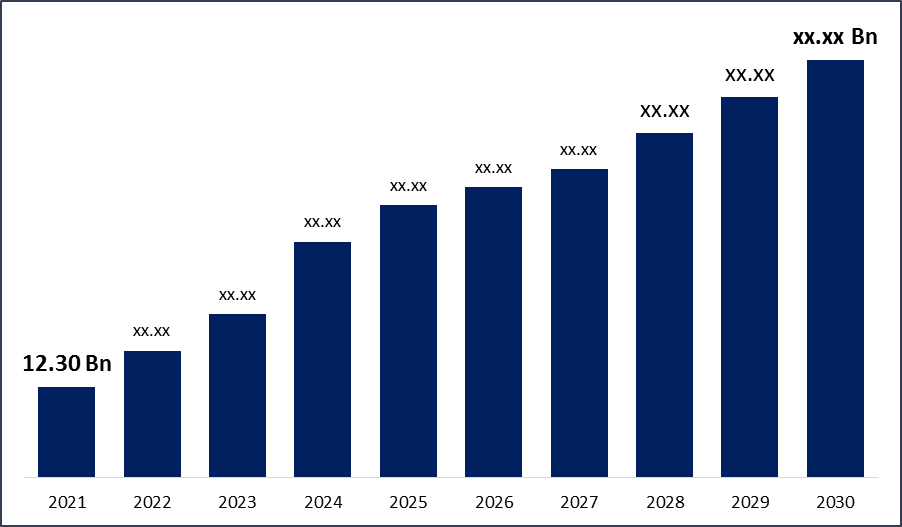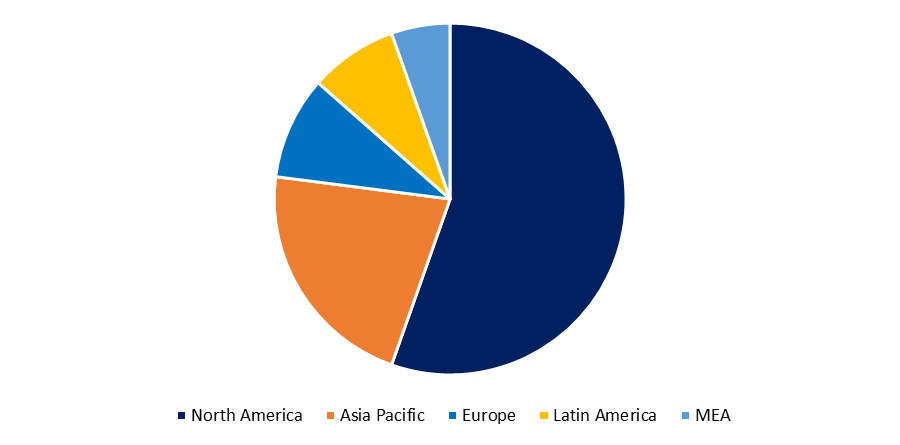Global Agriculture Technology-as-a-Service Market Size, Share & Trends, COVID-19 Impact Analysis Report, By Type (Software-as-a-Service, Equipment-as-a-Service), By Application (Farmland & Farms, Agricultural Cooperatives, and Others), and By Region (North America, Europe, Asia-Pacific, Latin America, and the Middle East and Africa), Analysis and Forecast 2022 - 2030
Industry: Information & TechnologyMARKET: OVERVIEW
The Global Agriculture Technology-as-a-Service Market Size was valued at USD 12.30 billion in 2021 and is expected to expand at a compound annual growth rate (CAGR) of 9.70% from 2022 to 2030. Agriculture is at the start of yet another revolution, with data and connectivity at the forefront. AI, analytics, linked sensors, and other emerging technologies have the potential to increase yields, improve water and another input efficiency, and foster sustainability and resilience in agricultural production and animal husbandry. Agriculture is one of the oldest and most prosperous professions. Agriculture technology evolves over generations, mirroring human progress. Over time, simple hoes and wheelbarrows gave way to tractors, combines, and other technology, as well as GMOs and the green revolution.

Get more details on this report -
Agriculture technology is rapidly evolving in the agricultural economy. A networked farm can offer numerous advantages, such as user data collection, high-precision crop control, and automated farming practices. The Internet of Things (IoT) has the potential to transform the landscape of current farming practices, which is one of its many benefits. Sensors in the Internet of Things provide information on agricultural production, insect infestation, soil nutrition, and rainfall. The Internet of Things provides precise data that can be used to improve agricultural operations.
MARKET: TREND
Rise of Drones in Agriculture Technology
Drones are increasingly being used in agriculture as part of an effective approach to sustainable agricultural management that enables agronomists, agricultural engineers, and farmers to help streamline their operations and gain useful insights into their crops through the use of powerful data analytics. Crop monitoring, for example, is simplified by the use of drone data to precisely plan and implement ongoing adjustments such as ditch placement and fertilizer application changes. Instead of the more traditional time and labor-intensive data collection methods, products can be correctly traced from farm to fork using GPS positions for every point along the way. UAVs excel at precisely monitoring large swaths of farmland, taking into account factors such as slope and elevation to determine the best planting prescriptions.
More precise data can help with replanting decisions, thinning and pruning actions, and crop model development and the technique is useful in providing a complete picture of plant emergence and population. Agricultural experts may use drone data's high resolution to measure crop fertility, allowing them to better apply fertilizer, reduce waste, and design - and troubleshoot - irrigation systems. Following natural disasters such as floods, the technology can be especially useful in assisting farmers in assessing damage over difficult-to-access terrains.
Global Agriculture Technology-as-a-Service Market Report Coverage
| Report Coverage | Details |
|---|---|
| Base Year: | 2021 |
| Market Size in 2021: | USD 12.30 billion |
| Forecast Period: | 2022 to 2030 |
| Forecast Period CAGR 2022 to 2030 : | 9.70% |
| Historical Data for: | 2017 to 2020 |
| No. of Pages: | 235 |
| Tables, Charts & Figures: | 119 |
| Segments covered: | By Type, By Application, By Region, COVID-19 Impact Analysis Report |
| Companies covered:: | AGCO, DJI, PrecisionHawk, Small Robot Company, Syngenta, Fujitsu, Accenture, CLAAS KGaA mbH, Ceres Imaging, Hexagon Agriculture, Taranis |
| Growth Drivers: | 1). Rise of Drones in Agriculture Technology. 2). The rise in the Adoption of Precision Farming Propel Market Growth |
| Pitfalls & Challenges: | Price Inflation of Agricultural Produce Hamper Market Growth |
Get more details on this report -
MARKET: DRIVERS
The rise in the Adoption of Precision Farming Propel Market Growth
Precision agriculture (PA) is being used as an agricultural data management strategy in a variety of modern agricultural contexts around the world. It is a management decision-making approach that takes spatial and temporal diversity into account to improve resource use efficiency, productivity, quality, profitability, and sustainability in agricultural production. The use of PA technologies in particular is intended to ensure long-term progress in all aspects of agricultural production while minimizing environmental impacts. Data collection technologies, such as global satellite positioning remote sensing technologies, soil sampling, and mapping, data processing and decision-making technologies, such as geographical information systems (GIS) and sensor networks, and application technologies, such as variable-rate technologies, can be divided into three categories (VRT).
Despite differences in attitudes toward PA technology and willingness to accept it, the study found that family farmers were open to the promise of PA technologies. Adoption rates will rise as adoption barriers are reduced, such as the need for low-cost PA applications that can be used on a small scale, improved information, and financial support mechanisms such as more accessible subsidies and credit, as well as reliable, regulated, and affordable service provider.
MARKET: RESTRAINT
Price Inflation of Agricultural Produce Hamper Market Growth
Increases in agricultural commodity prices are almost certain to raise the wholesale pricing index (WPI) and consumer price index (CPI) in the coming months. The current upward trend in food prices may usher in a new era of even higher food prices in the future. As the world's population and incomes rise, agricultural commodity supplies are likely to tighten even further, driving up demand. Crop-based food items also saw significant price increases. Following three years of gradual price increases, cereal and bakery product prices have risen dramatically. Demand was high both domestically and internationally, resulting in a 2.9 percent increase in fat and oil product prices. Fruit and vegetable prices began to fall following a freeze-damaged crop in the United States. Price increases in processed fruits and vegetables, on the other hand, have accelerated due to higher processing costs. Historically, food prices have risen in response to rising crude oil prices.
MARKET: SEGMENTATION
The Global Agriculture Technology-as-a-Service Market is segmented by type, application, and Region. Based on the type, the market is categorized into Software-as-a-Service and Equipment-as-a-Service. Based on the Application the market is bifurcated into Farmland & Farms, Agricultural Cooperatives, and Others. Based on the Region, the market is categorized into North America, Europe, Asia-Pacific, Latin America, and the Middle East and Africa.
MARKET SEGMENTATION: BY REGION
Based on the Region, the Agriculture Technology-as-a-Service Market is categorized into North America, Europe, Asia-Pacific, Latin America, and the Middle East and Africa.

Get more details on this report -
North America dominated the Global Agriculture Technology as a Service market during the forecast period 2022-2030. The market growth is generally attributed to the growing need to receive agribusiness advancements across the region's major industries, the conversion of capital use into operational consumption for clients, and exceptional client retention for specialist co-ops. The additional benefits of lower costs, adaptability, combination, and availability associated with ATaaS are also expected to be responsible for the detailed development of this strategy. However, Asia-Pacific and Japan are expected to have the fastest market growth, from 2021 to 2029, owing to the amount of arable land available, agriculture's reliance on the countries for economic and social growth, and government support in the form of subsidies, regulations, or research. Due to the late adoption of agricultural technologies and practices, Asia-Pacific and Japan are expected to have a smaller market share in 2021 than North America and Europe.
MARKET: COMPETITIVE LANDSCAPE
Companies in this industry are focusing on efficient growth, improving operational efficiency and productivity, achieving high safety standards, and focusing on long-term development. The players are working hard to secure a dominant position in this industry. They are constantly looking for ways to strengthen their competitive advantage. To achieve a high market share while also developing a socially responsible business, companies are identifying various strategic pillars such as mergers and acquisitions, new product launches, product enhancement, and others.
MARKET: RECENT DEVELOPMENT
- October 2020 - DeHaat introduced the franchise model to expand its operations in Eastern India. In this model, the company collaborates with small businesses in rural areas to obtain agricultural inputs from companies such as Bayer Crop Sciences and sell them to farmers, as well as to obtain farmers' produce within a 3-6-kilometer radius.
MARKET: KEY PLAYERS
- AGCO
- DJI
- PrecisionHawk
- Small Robot Company
- Syngenta
- Fujitsu
- Accenture
- CLAAS KGaA mbH
- Ceres Imaging
- Hexagon Agriculture
- Taranis
SCOPE OF THE REPORT
The reports also assist in understanding the dynamic and structure of the Agriculture Technology as a Service market. The study serves as an investor's guide with its clear representation of competitive analysis of key competitors by product, price, financial condition, product portfolio, growth plans, and regional presence in the market for Agriculture Technology-as-a-Service. Agriculture technology is rapidly evolving in the agricultural economy. A networked farm can offer numerous advantages, such as user data collection, high-precision crop control, and automated farming practices. The Internet of Things (IoT) has the potential to transform the landscape of current farming practices, which is one of its many benefits. Sensors in the Internet of Things provide information on agricultural production, insect infestation, soil nutrition, and rainfall. The Internet of Things provides precise data that can be used to improve agricultural operations.
Need help to buy this report?